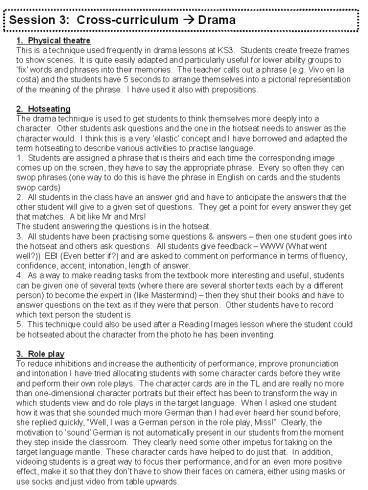Session%203:%20Cross-curriculum%20?%20Drama - PowerPoint PPT Presentation
Title:
Session%203:%20Cross-curriculum%20?%20Drama
Description:
This is a technique used frequently in drama lessons at KS3. ... show their faces on camera, either using masks or use socks and just video from table upwards. ... – PowerPoint PPT presentation
Number of Views:17
Avg rating:3.0/5.0
Title: Session%203:%20Cross-curriculum%20?%20Drama
1
Session 3 Cross-curriculum ? Drama
1. Physical theatreThis is a technique used
frequently in drama lessons at KS3. Students
create freeze frames to show scenes. It is quite
easily adapted and particularly useful for lower
ability groups to fix words and phrases into
their memories. The teacher calls out a phrase
(e.g. Vivo en la costa) and the students have 5
seconds to arrange themselves into a pictorial
representation of the meaning of the phrase. I
have used it also with prepositions.2.
HotseatingThe drama technique is used to get
students to think themselves more deeply into a
character. Other students ask questions and the
one in the hotseat needs to answer as the
character would. I think this is a very
elastic concept and I have borrowed and adapted
the term hotseating to describe various
activities to practise language. 1. Students
are assigned a phrase that is theirs and each
time the corresponding image comes up on the
screen, they have to say the appropriate phrase.
Every so often they can swop phrases (one way to
do this is have the phrase in English on cards
and the students swop cards)2. All students in
the class have an answer grid and have to
anticipate the answers that the other student
will give to a given set of questions. They get
a point for every answer they get that matches.
A bit like Mr and Mrs!The student answering the
questions is in the hotseat.3. All students
have been practising some questions answers
then one student goes into the hotseat and others
ask questions. All students give feedback WWW
(What went well?)) EBI (Even better if?) and are
asked to comment on performance in terms of
fluency, confidence, accent, intonation, length
of answer.4. As a way to make reading tasks
from the textbook more interesting and useful,
students can be given one of several texts (where
there are several shorter texts each by a
different person) to become the expert in (like
Mastermind) then they shut their books and have
to answer questions on the text as if they were
that person. Other students have to record which
text person the student is. 5. This technique
could also be used after a Reading Images lesson
where the student could be hotseated about the
character from the photo he has been
inventing.3. Role playTo reduce inhibitions
and increase the authenticity of performance,
improve pronunciation and intonation I have tried
allocating students with some character cards
before they write and perform their own role
plays. The character cards are in the TL and are
really no more than one-dimensional character
portraits but their effect has been to transform
the way in which students view and do role plays
in the target language. When I asked one student
how it was that she sounded much more German than
I had ever heard her sound before, she replied
quickly, Well, I was a German person in the role
play, Miss! Clearly, the motivation to sound
German is not automatically present in our
students from the moment they step inside the
classroom. They clearly need some other impetus
for taking on the target language mantle. These
character cards have helped to do just that. In
addition, videoing students is a great way to
focus their performance, and for an even more
positive effect, make it so that they dont have
to show their faces on camera, either using masks
or use socks and just video from table upwards.































